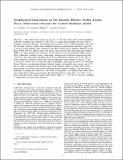| dc.contributor.author | Evans, Alex J. | |
| dc.contributor.author | Andrews-Hanna, Jeffrey C. | |
| dc.contributor.author | Zuber, Maria | |
| dc.date.accessioned | 2012-10-25T16:27:29Z | |
| dc.date.available | 2012-10-25T16:27:29Z | |
| dc.date.issued | 2010-05 | |
| dc.date.submitted | 2009-07 | |
| dc.identifier.issn | 0148-0227 | |
| dc.identifier.issn | 2156-2202 | |
| dc.identifier.uri | http://hdl.handle.net/1721.1/74249 | |
| dc.description.abstract | The Arabia Terra region, an area of ~1 × 10[superscript 7] km[superscript 2] lying south of the hemispheric dichotomy boundary and centered at (25E, 5N), is a unique physiographic province with topography and crustal thickness intermediate between those of the southern highlands and northern lowlands. Previous workers have identified numerous morphological indicators suggestive of erosion. Using altimetry data returned by the Mars Orbiter Laser Altimeter (MOLA) on the Mars Global Surveyor (MGS) along with gravity data from the Mars Reconnaissance Orbiter (MRO), we place geophysical constraints on the amount of erosion permitted within Arabia Terra. Admittance estimates using a multitaper, spatiospectral localization approach provide a best fit to the observations through degree 50 at an elastic lithosphere thickness of 15 km. The elevation difference between Arabia Terra and the highlands would require as much as 5 km of erosion in certain areas to yield the current topography, neglecting the effects of subsequent flexure. However, incorporating flexural rebound requires substantially more erosion, up to 25 km, in order to reproduce the elevation and crustal thickness deficit of Arabia Terra. Such a large amount of erosion would result in exterior flexural uplift surpassing 1 km and gravity anomalies exceeding observations by ∼60 mGal. Consequently, it is unlikely that Arabia Terra was formed from surface erosion alone. We determine that no more than 3 × 10[superscript 7] km[superscript 3] of material could have been removed from Arabia Terra, while 1.7 × 10[superscript 8] km[superscript 3] of erosion is required to explain the observed crustal thickness. | en_US |
| dc.language.iso | en_US | |
| dc.publisher | American Geophysical Union (AGU) | en_US |
| dc.relation.isversionof | http://dx.doi.org/ 10.1029/2009je003469 | en_US |
| dc.rights | Article is made available in accordance with the publisher's policy and may be subject to US copyright law. Please refer to the publisher's site for terms of use. | en_US |
| dc.source | MIT web domain | en_US |
| dc.title | Geophysical limitations on the erosion history within Arabia Terra | en_US |
| dc.type | Article | en_US |
| dc.identifier.citation | Evans, A. J., J. C. Andrews-Hanna, and M. T. Zuber. “Geophysical Limitations on the Erosion History Within Arabia Terra.” Journal of Geophysical Research 115.E5 (2010). ©2010 American Geophysical Union | en_US |
| dc.contributor.department | Massachusetts Institute of Technology. Department of Earth, Atmospheric, and Planetary Sciences | en_US |
| dc.contributor.mitauthor | Evans, Alex J. | |
| dc.contributor.mitauthor | Andrews-Hanna, Jeffrey C. | |
| dc.contributor.mitauthor | Zuber, Maria | |
| dc.relation.journal | Journal of Geophysical Research Planets | en_US |
| dc.eprint.version | Final published version | en_US |
| dc.type.uri | http://purl.org/eprint/type/JournalArticle | en_US |
| eprint.status | http://purl.org/eprint/status/PeerReviewed | en_US |
| dspace.orderedauthors | Evans, A. J.; Andrews-Hanna, J. C.; Zuber, M. T. | en |
| dc.identifier.orcid | https://orcid.org/0000-0003-2652-8017 | |
| mit.license | PUBLISHER_POLICY | en_US |
| mit.metadata.status | Complete | |
